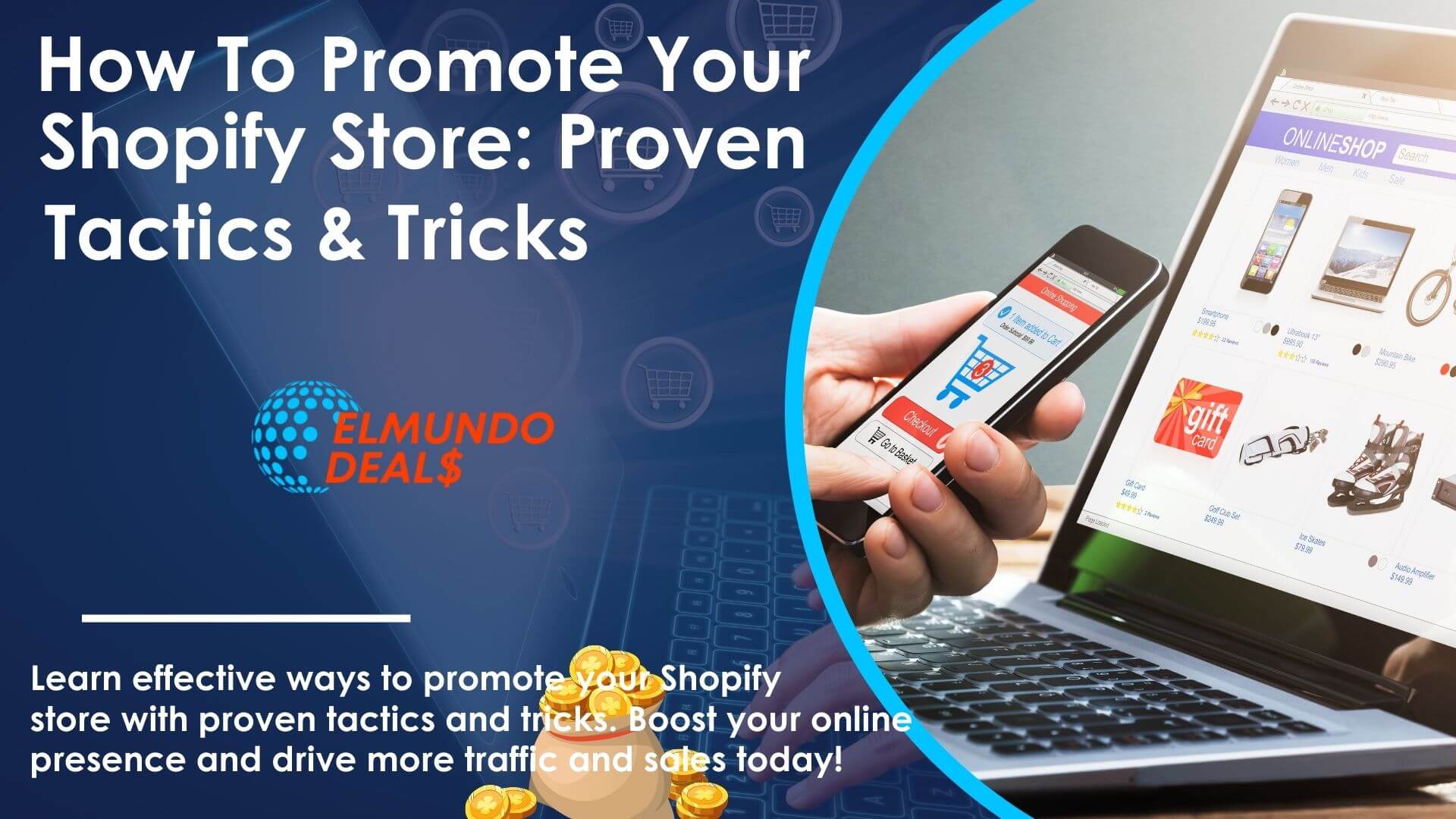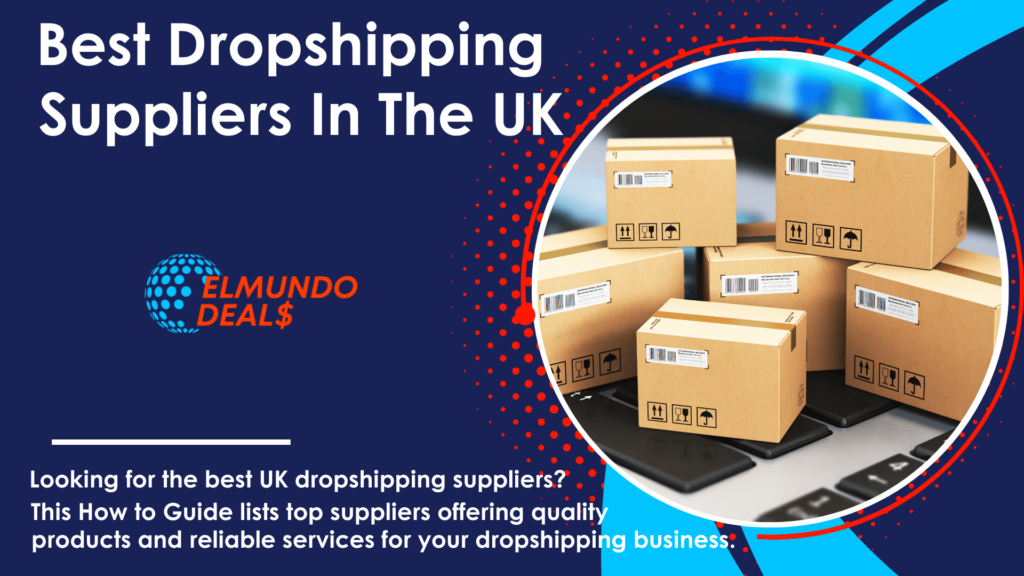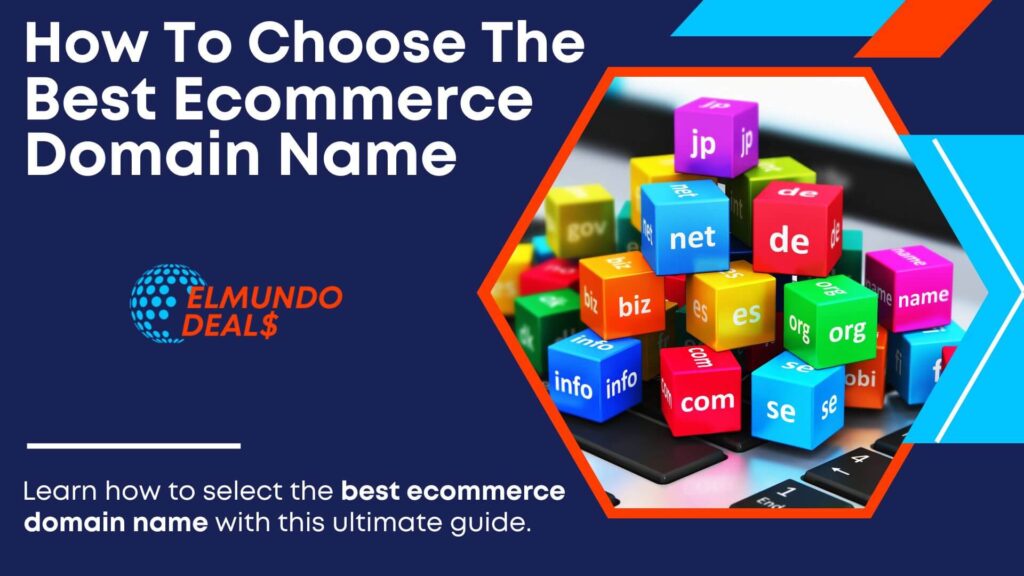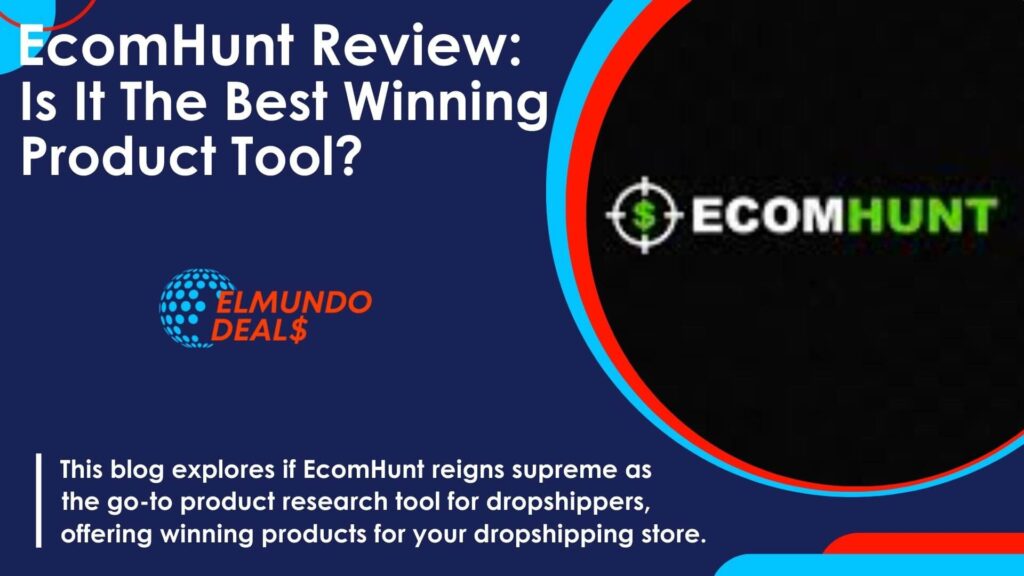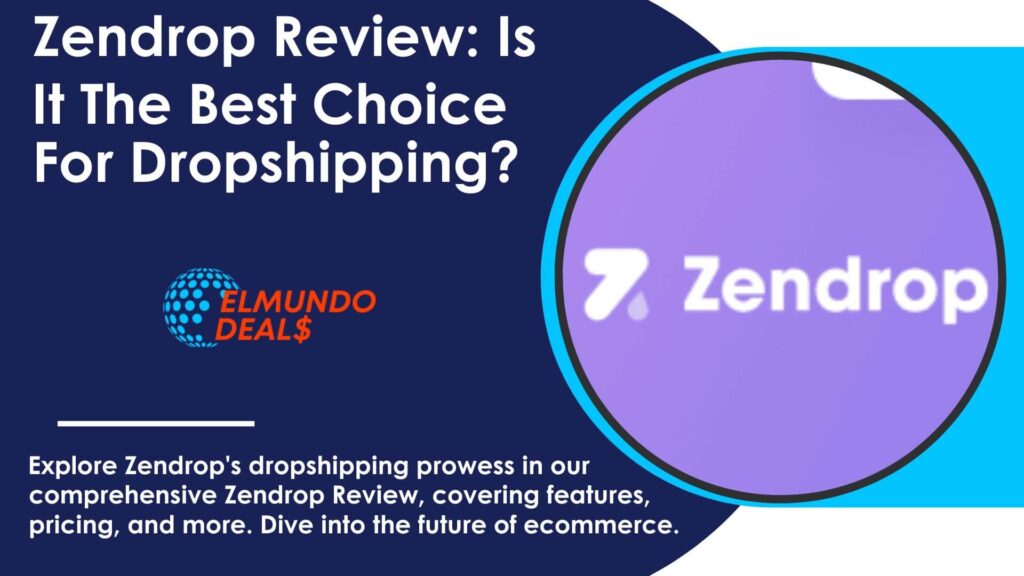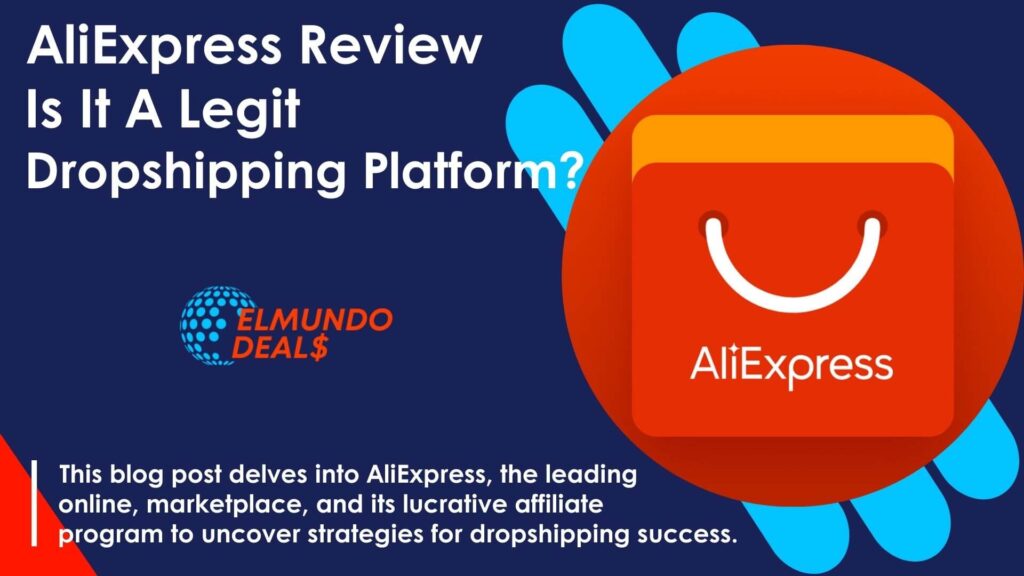How To Promote Your Shopify Store In 2024 – 25 Ways To Promote Your Business
Congratulations on launching your Shopify store! You’ve poured your heart and soul into crafting a unique brand and selecting the perfect products. But now comes the crucial question: how do you attract customers and turn them into loyal fans?
In today’s digital world, establishing an online presence is crucial for any business, especially those operating on platforms like Shopify. However, just having a Shopify store isn’t enough; you must actively promote it to attract customers and drive sales.
This comprehensive guide explores 25 effective strategies, categorized into free or low-cost methods, social media tactics, and local marketing techniques, to promote your Shopify store and elevate your online business to new heights.
Key Takeaways:
1. Craft Compelling Content: Creating informative and engaging content through blogging and video marketing is crucial for attracting and engaging your audience.
2. Leverage Social Media Marketing: Engage with your audience on platforms like Instagram and utilize Facebook advertising to promote your products and drive traffic.
3. Optimize Your Website for Search Engines: Conduct keyword research and optimize your website’s on-page elements to improve its visibility in search engine results.
4. Build Relationships with Influencers and Bloggers: Collaborating with influencers and bloggers can help you expand your reach, build credibility, and drive traffic to your Shopify store.
5. Offer Compelling Discounts and Promotions: Limited-time offers and loyalty programs can incentivize purchases and encourage customer retention.
Tips To Promote Your Shopify Website: Content is King and Queen
Launching a Shopify website is just the beginning. To ensure its success, you need to actively promote it using various marketing strategies. Here are some tips to get you started:
Advertise Your Shopify Store For Free Or Through Low-Paid Ads With These 25 Marketing Strategies
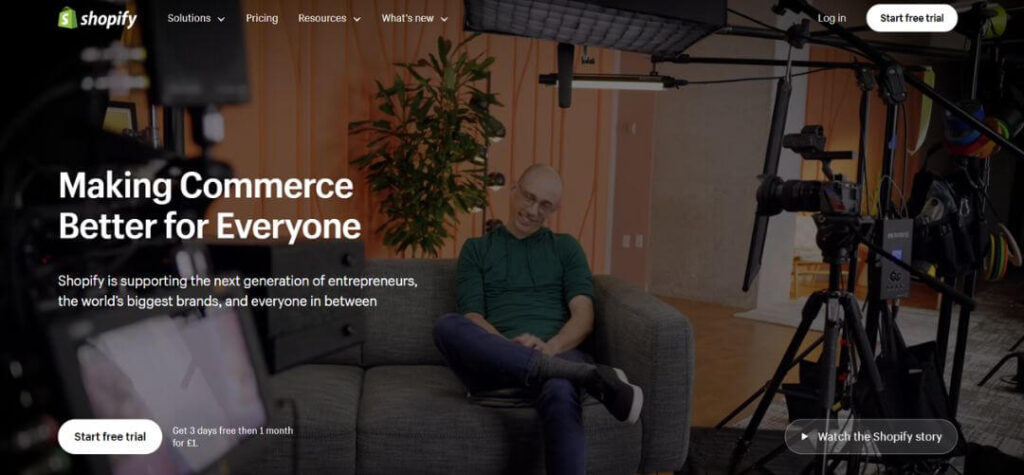
1. Write guest posts for blogs that reach your target audience
Expanding your online presence beyond your website is crucial to attracting new customers and amplifying your brand awareness. Guest posting offers a strategic avenue to achieve this by partnering with established blogs in your niche and contributing valuable content tailored to their audience’s interests.
Here’s how guest posting can fuel your Shopify store’s growth:
- Increased brand exposure: Reach a wider audience of potential customers already interested in your niche, leveraging the established blog’s audience base.
- Enhanced brand awareness: Each guest post acts as a mini-advertisement, increasing brand recognition and positioning you as an authority within your field.
- Targeted traffic generation: Include strategic calls to action within your posts, directing readers back to your website to explore products or learn more about your brand.
- Improved SEO: Backlinks from high-authority websites can significantly enhance your search engine ranking, making your Shopify store more discoverable in organic search results.
Crafting high-quality guest posts is crucial. Focus on creating engaging content that resonates with the blog’s audience, fostering trust, and driving valuable traffic to your Shopify store. This approach builds niche relationships, potentially converting readers into loyal customers, a key marketing tactic for promoting a Shopify store.
Free traffic, unlike paid ads, is vital for new websites. While blogging generates traffic, guest posting expands your reach, boosting search engine optimization. Connect with niche bloggers, offering relevant guest posts to maximize effectiveness and drive traffic. Ensure topics align with your niche for optimal results.
2. Get featured on product review blog posts
Positive customer reviews and testimonials hold immense power in influencing purchasing decisions and can effectively promote a Shopify store when highlighted prominently.
Potential customers often rely on the experiences and opinions of others before making a purchase. Product review bloggers can play a crucial role in this process by providing unbiased reviews of your products to their audience.
Here’s how partnering with product review bloggers can benefit your Shopify store:
- Enhanced trust and credibility: Positive reviews from established bloggers build trust and credibility with potential customers, who are likelier to purchase from a brand with strong social proof.
- Increased brand awareness: Product reviews expose your brand to a wider audience, particularly those actively searching for information about products like yours.
- Valuable customer insights: Reviews can offer valuable insights into customer perception and satisfaction with your products, allowing you to identify areas for improvement and enhance your overall product offerings.
To leverage this strategy effectively:
- Identify relevant review bloggers: Research and identify established bloggers within your niche who align with your target audience and consistently produce high-quality reviews.
- Offer samples in exchange for honest reviews: a practical approach for ecommerce store owners to gain valuable feedback. Provide bloggers with free samples of your products in exchange for their honest and unbiased reviews, a tried and tested method to promote Shopify stores.
- Respond to reviews professionally: Engage professionally with positive and negative reviews, addressing any concerns and demonstrating your commitment to customer satisfaction.
By strategically partnering with product review bloggers, you can harness the power of word-of-mouth marketing, build trust with potential customers, and ultimately drive sales for your Shopify store.
3. Do an expert roundup
In the ever-evolving world of e-commerce, establishing yourself as a thought leader within your niche holds immense value. Expert roundups present a unique opportunity to collaborate with other industry leaders and amplify your reach to a broader audience.
These roundups typically involve compiling insights and perspectives from various experts on a specific topic relevant to your industry. By participating in such roundups, you gain several advantages:
- Increased exposure: Gain access to the established roundup platform’s audience, potentially reaching a broader pool of individuals interested in your field of expertise.
- Enhanced brand credibility: Associating your brand with other industry leaders strengthens your credibility and positions you as an authority in your niche.
- Content diversification: Participating in roundups allows you to showcase your expertise beyond your website, offering valuable insights in a concise and impactful format.
To maximize the benefits of expert roundups:
- Identify relevant opportunities: Research industry roundups that align with your expertise and target audience, presenting a golden opportunity for Shopify store owners to showcase their products.
- Craft insightful contributions: Provide well-researched, informative, and engaging responses to the roundup topic, demonstrating your knowledge and offering valuable insights to the audience, which is another excellent way to promote your Shopify business.
- Promote your participation: Share your participation in the roundup across your social media platforms and website, further amplifying your reach and driving traffic back to your store.
By strategically participating in expert roundups, you can leverage other industry leaders’ combined reach and influence, establish yourself as a thought leader, and ultimately attract potential customers interested in your expertise and the products you offer.
4. Find affiliates to promote your store
Affiliate marketing offers a powerful tool to reach new audiences and drive sales for your Shopify store without upfront costs. You can leverage their established audiences and expertise to promote your products by partnering with the right individuals or businesses.
Here are vital steps to maximize success:
- Identify relevant affiliates: Seek out partners with established audiences that complement your niche and target market. Look for individuals or businesses who share your brand values and resonate with your ideal customer.
- Develop a compelling program: consider incorporating referral marketing to encourage existing customers to promote your Shopify store. Designing an attractive program with competitive commission rates, high-quality marketing materials, and timely payouts, essential to maintaining trust and loyalty with partners, can significantly boost your store’s reputation and indirectly drive traffic and sales. To incentivize affiliates and foster strong partnerships.
- Track and optimize: use Shopify apps to analyze the performance of your marketing tactics and refine them for better outcomes. Monitor program performance to identify top performers. Regularly analyze data and optimize program elements like commission structures and marketing materials to maximize return on investment.
5. Get included in gift guides
Gift guides and curated collections of products for specific occasions or recipients offer a valuable opportunity to expose your products to targeted audiences and drive sales during peak shopping seasons. Here’s how to secure your spot:
- Identify relevant guides: Research publications, websites, or social media influencers who create gift guides, as this can be an effective marketing tactic to boost sales for your Shopify store, promoting traffic and sales during the holiday season. They are aligned with your products and target audience.
- Craft a compelling pitch: Highlight the Unique selling points crucial in differentiating your online store from competitors. Explain how your products perfectly fit the gift guide’s theme and target audience. Include high-quality product images and detailed descriptions to enhance your pitch.
- Build relationships: Proactively connect with gift guide creators and nurture relationships. Offer valuable resources or early access to new products to increase your chances of inclusion in future guides.
By implementing these steps well in advance of peak shopping seasons, you can leverage gift guides to reach targeted gift shoppers and boost your sales effectively.
6. Invest in infographics
In today’s fast-paced world, people are bombarded with information. Capturing and retaining their attention requires engaging and easily digestible content formats. Infographics offer a powerful solution, transforming complex information into visually appealing and easily understandable graphics.
Here’s how infographics can benefit your Shopify store:
- Increased engagement: Compelling visuals like charts, graphs, and icons capture attention and make complex information more digestible, leading to higher engagement with your content.
- Improved information retention: People are more likely to remember information presented visually, making infographics an effective tool for conveying critical messages about your products or brand.
- Enhanced shareability: Infographics are highly shareable across social media platforms and other websites, potentially reaching a wider audience and amplifying your brand awareness.
To create impactful infographics:
- Focus on a clear message: Ensure your infographic has a clear and concise message you want your audience to remember.
- Prioritize visual appeal: Use high-quality visuals, consistent design elements, and a straightforward layout to make your infographic visually appealing and easy to follow.
- Incorporate data and statistics: Leverage data and statistics to support your message and add credibility to your infographic.
- Include a call to action: Encourage viewers to learn more about your brand or visit your store by including a clear call to action at the end of your infographic.
By creating informative and visually appealing infographics, you can effectively communicate complex information, engage your audience, and ultimately drive traffic and potential customers to your Shopify store.
7. Get press coverage
Securing press coverage from reputable media outlets can significantly elevate your brand visibility and credibility. To grab the attention of journalists and editors, develop compelling press releases or story pitches that highlight the following:
- Identify relevant media outlets: Research publications, websites, or journalists who cover your industry or product niche. Look for media outlets with a readership that aligns with your target audience.
- Develop newsworthy stories: Craft compelling press releases or story ideas that highlight new product launches, Company milestones, or unique aspects of your brand that resonate with the target media outlet’s audience.
- Build relationships with journalists: Foster relationships with journalists by providing valuable insights, responding promptly to inquiries, and offering exclusive content or interviews when possible.
8. Focus your attention on the email marketing campaign
In the ever-evolving digital marketing landscape, email remains a powerful tool for fostering relationships with potential customers and driving sales. Building a robust email list lets you connect with your audience directly, share valuable content, promote new products, and nurture leads toward conversion.
Here are some strategies to effectively build your email list:
- Offer valuable lead magnets: Provide potential customers with incentives to subscribe to your email list, such as exclusive discounts, early access to new products, downloadable resources like e-books or cheat sheets, or access to exclusive content.
- Create high-quality signup forms: Design user-friendly ones that are easy to find and navigate on your website. Keep the required information minimal to avoid discouraging potential subscribers.
- Integrate signup forms strategically: Place signup forms in various locations on your website, such as your homepage, product pages, blog posts, and checkout pages.
- Run targeted contests and giveaways: Host contests or giveaways that require email signup as an entry method. This helps you build your list and generates excitement and brand awareness.
Once you’ve built your email list, the key lies in nurturing relationships with your subscribers. Here are some effective practices:
- Segment your list: Divide your email list into segments based on subscriber interests, purchase history, or demographics. This allows you to send targeted emails catering to each segment’s specific needs and preferences.
- Craft engaging email content: Develop personalized email campaigns that offer valuable content, promote relevant products, share industry insights, or highlight customer testimonials.
- Maintain a consistent sending schedule: Establish a regular email sending schedule to stay top-of-mind with your subscribers without overwhelming them.
- Track and analyze results: Monitor the performance of your email campaigns by analyzing key metrics like open rates, click-through rates, and conversion rates. This data allows you to refine your approach and continuously improve the effectiveness of your email marketing efforts.
By implementing these strategies, you can build a valuable email list, nurture relationships with potential customers, and drive sales and brand loyalty for your Shopify store.
9. Get to the top of Google search results
In today’s digital age, consumers often turn to search engines like Google to find the needed products. Optimizing your Shopify store for search engines, also known as Search Engine Optimization (SEO), is crucial to improving your visibility in organic search results and attracting potential customers actively searching for products like yours.
Here are some key aspects of SEO for your Shopify store:
- Keyword research: Identify relevant keywords your target audience uses to search for products or services related to your offerings. Integrate these keywords strategically throughout your product descriptions, titles, website content, and meta descriptions.
- Content optimization: Create high-quality, informative, and engaging content that resonates with your target audience and incorporates relevant keywords naturally. This content can include product descriptions, blog posts, articles, or infographics.
- Technical SEO: Ensure your website is technically sound and mobile-friendly. This includes aspects like website speed, navigation structure, and code optimization.
- Backlink building: Acquire backlinks from high-quality and relevant websites within your niche. Backlinks act as votes of confidence for your website and can significantly improve your search engine ranking.
While SEO is a complex and ever-evolving field, focusing on these core principles can help you improve your store’s visibility in organic search results and attract potential customers actively searching for products like yours. Remember, SEO is an ongoing process; consistent effort and refinement are essential to achieving optimal results.
Strategies To Promote Your Shopify Store On Social Media
10. Get on TikTok
The short-form video platform TikTok has taken the world by storm, particularly captivating the Gen Z demographic. While you might not initially associate it with e-commerce, neglecting its potential for promoting your Shopify store would be a missed opportunity.
Here’s how you can leverage TikTok for your Shopify store:
- Showcase your products in a fun and engaging way: Utilize the platform’s creative tools and trending sounds to create short, engaging videos that showcase your products in action, highlight their unique features, or demonstrate different use cases.
- Partner with relevant TikTok influencers: Collaborate with micro or macro-influencers who align with your brand and target audience. Leverage their established audience to reach a wider pool of potential customers and generate brand awareness.
- Run creative hashtag challenges: This can be a fun way to promote your products, generate user-generated content, and increase brand awareness. Encourage users to create videos using your branded hashtag while showcasing your products creatively and engagingly.
11. Start a YouTube channel
While TikTok caters to short-form video content, YouTube offers a platform for creating longer, more in-depth content that can nurture brand loyalty and educate your audience.
Here are some ways to utilize YouTube for your Shopify store:
- Create informative and entertaining videos: Develop content beyond simply showcasing your products. Educate your audience by offering product tutorials, behind-the-scenes glimpses into your brand, customer testimonials, or industry-related insights.
- Build a community around your brand: Foster engagement by responding to comments, hosting live Q&A sessions, and encouraging viewers to subscribe to your channel and interact with your content.
- Optimize your videos for search: Utilize relevant keywords in your video titles, descriptions, and tags to improve your discoverability in YouTube search results.
By consistently creating high-quality and engaging video content on YouTube, you can build brand loyalty, educate your audience, and drive sales for your Shopify store.
12. Ask influencers to promote your business
Influencer marketing has become a powerful tool for promoting products and reaching new audiences. Partnering with relevant influencers who resonate with your target audience can significantly amplify your brand awareness and drive sales.
Here are some key considerations for successful influencer marketing:
- Identify the right influencers: Focus on something other than follower count. Choose influencers who align with your brand values, target audience, and niche. Look for individuals who actively engage with their audience and are genuinely interested in your products.
- Establish clear campaign goals and expectations: Determine the specific objectives you aim to achieve through your influencer campaign, such as brand awareness, increased website traffic, or driving sales. Communicate these goals and expectations clearly to the influencer you choose to partner with.
- Develop engaging and authentic content: Encourage the influencer to create content that feels natural and aligns with their usual style while effectively showcasing your products and their benefits.
By implementing these strategies, you can leverage the power of influencer marketing to reach a wider audience, build trust with potential customers, and ultimately drive sales for your Shopify store.
13. Put up compelling social media posts frequently
In today’s digital world, social media platforms are powerful tools for connecting with potential customers, building brand awareness, and ultimately driving sales for your Shopify store.
Here are some critical strategies for creating compelling social media posts:
- Visually appealing content: Utilize high-quality images, captivating videos, and engaging graphics to grab attention and stop users scrolling.
- Informative and engaging captions: Craft informative and interesting captions that tell a story, ask questions, spark conversations, or offer valuable insights related to your products or niche—an effective way to market your Shopify business.
- Post consistently: Maintain a consistent posting schedule across your chosen social media platforms. This helps you stay top-of-mind with your audience and foster a sense of community.
- Utilize relevant hashtags: Incorporate relevant hashtags in your posts to increase discoverability and reach a wider audience that is actively searching for content related to those hashtags. This is an effective way to promote your Shopify store on social media platforms.
- Run engaging contests and giveaways: an effective way to market and drive traffic to your Shopify store. Host interactive contests or giveaways to generate excitement, encourage audience participation, and potentially attract new followers.
By consistently creating and sharing visually appealing, informative, and engaging content across your social media platforms, you can capture attention, drive engagement, and ultimately convert followers into loyal customers for your Shopify store.
14. Automate word-of-mouth with social reviews
Positive customer reviews and testimonials hold immense power in influencing purchasing decisions, which is crucial for any store owner looking to boost traffic to their Shopify store. By encouraging customer reviews, you can leverage the power of word-of-mouth marketing and build trust with potential customers who are more likely to purchase from a brand with strong social proof.
Here are some ways to encourage customer reviews:
- Make it easy to leave reviews: Include clear and easy-to-find review sections on your product pages and website. Consider integrating with platforms like Google My Business or Yelp to encourage customers to leave reviews there as well.
- Offer incentives for reviews: While directly offering cash payments for reviews is generally not recommended, consider offering small incentives like exclusive discounts or early access to new products in exchange for customer reviews.
- Respond to all positive and negative reviews: Demonstrate your commitment to customer satisfaction by responding to all positive and negative reviews. Thank customers for their positive feedback and professionally and promptly address any concerns raised in negative reviews.
By encouraging customer reviews and actively managing your online reputation, you can leverage the power of word-of-mouth marketing, build trust with potential customers, and ultimately drive sales for your Shopify store.
15. Create micro-content for social feeds
Micro-content, consisting of bite-sized and easily digestible content, offers a unique opportunity to engage your audience and promote your brand effectively.
Here are some practical ways to utilize micro-content for your Shopify store:
- Short product demos: Showcase your products in action through short and engaging video demonstrations highlighting key features and benefits. This tactic can significantly stimulate traffic and sales for your ecommerce store.
- Customer testimonials: Share snippets of positive customer testimonials or reviews in text or video format to build trust and social proof.
- Behind-the-scenes glimpses: Offer a sneak peek into your brand story, production process, or team culture through short videos or photos to foster a sense of connection with your audience.
- Quick tips and tricks: Share bite-sized informational content related to your niche or product usage in the form of short videos, infographics, or carousel posts.
By incorporating micro-content into your social media strategy, you can effectively capture attention, keep your audience engaged, and ultimately drive them to explore your Shopify store and your products in more detail.
16. Go live with your followers
Live streaming provides a unique opportunity to connect with your audience in real-time, fostering a sense of community and engagement. Platforms like Instagram Live, YouTube Live, or TikTok Live offer excellent avenues to leverage this powerful tool.
Here are some ideas for hosting live streams to promote your Shopify store: engaging with your audience in real-time can significantly boost sales.
- Product launches and demonstrations: Host live streams to unveil new products, showcase their features and functionalities in detail, and answer audience questions in real-time.
- Q&A sessions: Engage directly with your audience by hosting live Q&A sessions where you address their questions and concerns about your brand or products.
- Behind-the-scenes tours: Offer your audience a glimpse into your brand story, production process, or team culture through live video tours.
- Collaborations with influencers: Partner with relevant influencers to host live streams, allowing them to showcase your products to their audience and foster authenticity and trust.
17. Make it easy to share your products
Building a solid community around your brand goes beyond simply having followers on social media. It’s about fostering genuine connections, encouraging interaction, and creating a space where your audience feels valued and heard.
Here are some ways to foster a thriving community around your Shopify store:
- Create engaging content: Share content that sparks conversations encourages interaction and resonates with your target audience’s interests and values.
- Respond to comments and messages: Actively engage with your audience by responding promptly and thoughtfully to comments on your posts, messages, and questions.
- Host online and offline events: Organize events like webinars, live Q&A sessions, or contests. Consider hosting offline events like workshops or pop-up shops to connect with your local community and strengthen relationships.
- Recognize and appreciate your loyal customers: Show appreciation for your most engaged followers and brand advocates by highlighting their contributions, offering exclusive discounts, or featuring them on your social media platforms.
By fostering a sense of community, you can create a loyal following, encourage brand advocacy, and ultimately drive sales and long-term customer loyalty for your Shopify store.
18. Be active on brand-appropriate trending topics
Paid advertising on platforms like Google Ads, Facebook Ads, Instagram Ads, or TikTok Ads can be a powerful tool for reaching a wider audience and achieving targeted growth for your Shopify store.
Here are some key considerations for utilizing paid advertising effectively:
- Define your target audience: Identify your ideal customer and tailor your ad campaigns to reach individuals most likely interested in your products.
- Set clear campaign objectives: Determine what you want to achieve with your paid advertising campaigns, such as increasing website traffic, driving sales, or generating leads.
- Craft compelling ad copy and visuals: Utilize captivating visuals and clear, concise messaging that resonates with your target audience and entices them to click on your ads.
- Set realistic budgets and track your results: Allocate a realistic budget for your advertising campaigns, including referral marketing, and closely monitor their performance to boost your Shopify store sales. Analyze critical metrics like click-through rates, conversion rates, and return on investment (ROI) to refine your approach and optimize your campaigns for better results.
While paid advertising can be effective, it requires careful planning, execution, and ongoing optimization. Consider seeking professional assistance if you’re new to paid advertising to ensure you maximize your return on investment.
19. Create quizzes and other interactive content
Harness the power of user-generated content (UGC). To build trust, authenticity, and brand loyalty, every store owner needs to genuinely engage with their customer base.
- Run UGC contests and giveaways: Encourage customers to share photos or videos using your products on social media with a designated branded hashtag. Offer incentives like discounts, free products, or contest prizes to encourage participation.
- Feature UGC on your website and social media: Showcase user-generated content on your website, social media platforms, and marketing materials. This demonstrates the real-world use of your products, builds trust with potential customers, and adds a touch of authenticity to your brand image.
- Respond to and engage with UGC creators: Acknowledge and appreciate user-generated content by responding to comments, sharing their posts, and featuring them on your platforms. This fosters a sense of community and encourages further UGC creation.
20. Enable shoppable feeds on all social media channels
Embrace the power of shoppable feeds on platforms like Instagram and Pinterest. These features allow users to seamlessly browse and purchase products directly from your social media feed, creating a frictionless shopping experience.
- Engagingly showcase your products: Utilize high-quality visuals and captivating captions to showcase your products in a way that entices users to stop scrolling and explore further.
- Tag your products accurately: ensuring your online store’s products are discoverable through search can significantly boost sales. Ensure your products are accurately tagged within your social media posts, allowing users to click directly on the product tag and be directed to the product page on your Shopify store to learn more and complete their purchase.
- Run targeted ad campaigns: Utilize platform advertising features to target your ideal customer with shoppable feed ads, increasing the reach and potential impact of your product showcases.
21. Test out retargeting ads
Don’t let potential customers slip away! Utilize retargeting ad campaigns to reach website visitors who haven’t converted yet. These ads can follow users across the internet, reminding them of your products and enticing them to return to your store and complete their purchase.
- Identify website visitors who still need to convert: targeting them with specific offers could effectively promote your Shopify store. Leverage website analytics tools to identify users who have browsed your products or added items to their cart but haven’t completed the purchase.
- Craft compelling retargeting ad creatives: Design retargeting ads that are visually appealing and relevant to the products or pages users previously viewed on your store. Offer special incentives like discounts or limited-time promotions to encourage them to return and complete their purchase.
- Set retargeting ad frequency limitations: Avoid bombarding users with excessive retargeting ads, which can lead to ad fatigue and negatively impact your brand perception.
How To Market Your Shopify Store Locally?
22. Create a Business Profile on Google
Connect with your local community and establish yourself as a local authority by implementing local marketing strategies.
Connect with Your Local Community:
- Claim Your Google My Business Profile: Create and optimize your Google My Business profile to ensure your store appears in local search results. This increases visibility for potential customers searching for businesses in your area.
- Engage in Local Events: Participate in local fairs, markets, or community events to showcase your products and connect with potential customers face-to-face. Offer product demonstrations, giveaways, or special promotions to attract attention and generate interest.
- Offer Local Delivery: If feasible, consider offering Local delivery options that can be promoted as a unique selling point for your online store, enhancing customer satisfaction and loyalty, to cater to customers in your vicinity. This adds convenience and incentivizes local purchases.
23. Join local events and connect with local customers
Forge strategic partnerships with complementary businesses to reach new audiences and expand your brand reach, which is especially beneficial for e-commerce store owners aiming for increased visibility.
- Identify potential partners: Look for businesses that cater to a similar target audience but offer non-competing products or services. Consider collaborating with local businesses, influencers, or other brands within your niche.
- Develop mutually beneficial partnerships: Explore co-marketing opportunities, cross-promotions, or product bundles that benefit both businesses and offer added value to your respective customer bases.
- Leverage each other’s strengths: Combine your marketing efforts and resources to reach a wider audience and achieve mutually beneficial outcomes.
24. Offer local delivery
Provide exceptional customer service to build trust, foster positive brand perception, and encourage repeat business.
- Train your team effectively: Ensure your customer service representatives are well-equipped with the knowledge and skills to handle customer inquiries, complaints, and requests efficiently and professionally.
- Be responsive and attentive: Respond to customer inquiries promptly through various channels, including email, phone, and social media, a best practice for any store owner wondering how to promote their Shopify store and build customer loyalty. Actively listen to their concerns and strive to resolve issues effectively and efficiently.
- Go the extra mile: Exceed customer expectations by offering personalized assistance and proactive support and exceeding base-level service standards. This fosters customer loyalty and encourages positive word-of-mouth recommendations.
25. Get local press
Reach a wider audience within your local community by securing local press coverage.
- Identify relevant local media outlets: Research newspapers, magazines, online publications, or local radio stations that cater to your target audience and niche.
- Craft a newsworthy story: Develop a compelling story about your brand, products, or unique selling proposition that would resonate with the local media and their audience. This story can be a powerful way to promote your Shopify store.
- Reach out to journalists and editors: Pitch your story to relevant journalists or editors at your identified local media outlets. Be professional and concise, and highlight the newsworthy aspects of your brand or story.
By implementing these local marketing strategies, you can establish a strong presence within your community, connect with potential customers on a personal level, and ultimately drive sales for your Shopify store.
Improve your digital marketing game.
Beyond these 25 strategies, consider exploring additional tactics to further refine your digital marketing game by monitoring your results, analyzing customer feedback, and adapting your approach to stay relevant and competitive in the ever-evolving digital landscape:
- Invest in paid advertising: Utilize platforms like Google Ads or social media advertising to reach a wider audience and target specific demographics.
- Explore paid social media marketing: Consider running targeted social media ad campaigns to reach potential customers who are more likely to be interested in your products, leveraging search ads to market your Shopify store effectively.
- Utilize marketing automation tools: Automate repetitive tasks like email marketing campaigns or social media posting to save time and improve efficiency.
- A/B test different marketing strategies: Continuously test and refine your marketing strategies by running A/B tests to see which approaches resonate best with your audience.
Conclusion: How To Promote Your Shopify Store In 2024
In today’s competitive digital landscape, promoting your Shopify store requires a strategic and multi-faceted approach. By crafting compelling content, leveraging social media marketing, optimizing your website for search engines, building relationships with influencers, and offering compelling discounts and promotions, you can effectively promote your Shopify store, attract more customers, and drive sales.
Promote Your Shopify Store FAQs
How can I advertise my small business?
The strategies mentioned above offer a variety of options for promoting your small business, from free and low-cost methods like content marketing and social media engagement to paid advertising options like Google Ads and social media marketing.
How can I promote my Shopify store for free?
Several free and low-cost methods can effectively promote your Shopify store, including content marketing (blogging, guest posting), social media marketing (organic posting, influencer marketing), email marketing, and local marketing (community events, Google My Business profile).
How do I get more customers for my business?
By implementing a comprehensive marketing strategy combining various tactics (content marketing, social media marketing, email marketing, SEO, paid advertising), you can attract a wider audience, build brand awareness, and convert more visitors into paying customers.
How do I attract and keep customers?
Providing a high-quality customer experience is crucial for attracting and retaining customers. This includes offering excellent customer service, building trust through transparency, and creating a sense of community around your brand.

